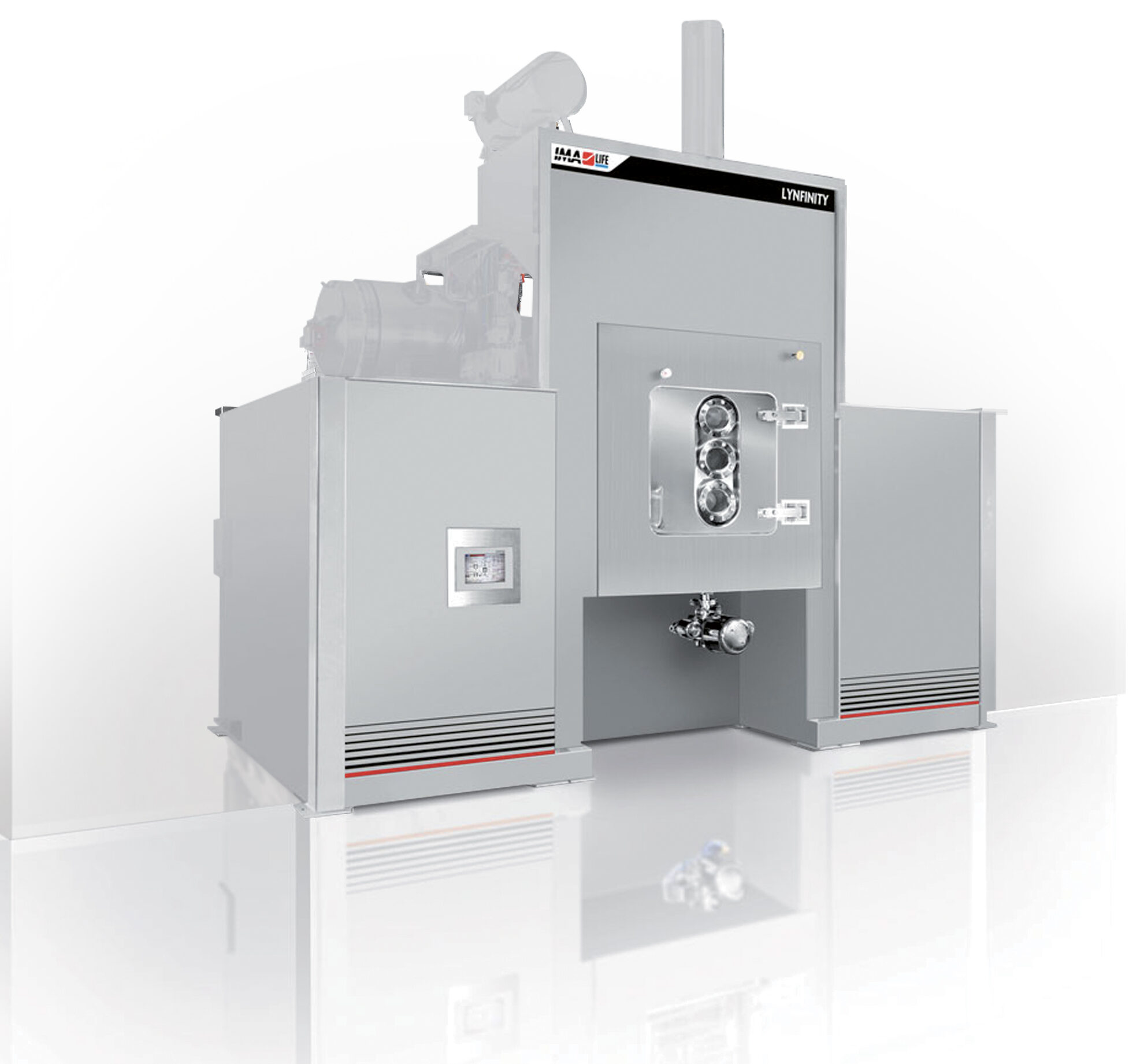
Continuous Aseptic Spray Freeze Drying.
IMA Life is a leader in the field of aseptic processing, filling technology and freeze drying solutions and can be considered a true partner to the pharmaceutical and bio-pharmaceutical industry, offering a wide range of technologically advanced machines.
For more than half a century, IMA Life has provided the benchmark for freeze-drying solutions to the pharmaceutical and biotech industry. IMA Life’s steady investments in R&D initiatives have resulted in innovative solutions in liophilisation, process and technologies such as Lynfinity, a robust yet gentle continuous aseptic process for spray freeze drying.

Figure 1. The Lynfinity Continuous Aseptic Spray Freeze Drying.
Increasing productivity and reducing downtime is made possible in a continuous aseptic process. Freeze drying is a critical unit operation in the production of sterile injectable medicines. Once considered a novelty drug form, there are currently more than 472 FDA approved lyophilized drugs (Greystone Research Associates, 2016).
Key factors in the growth of freeze drying include the number of biological drugs brought to market, and the push towards self-administration of medicines.
Freeze-drying is a low-pressure, low-temperature water vapor pumping process widely used in the manufacture of bio-pharmaceutical products for removal of solvents via sublimation.
Freeze drying has traditionally been a batch process, making it both time-consuming and energy intensive (Rambhatla et al., 2003; Liu et al., 2008). Conventionally, the drug product is placed in glass vials or bulk trays directly onto the freeze dryer shelves. Poor thermal contact between the shelf and product containers was shown to be the rate limiting resistance to heat transfer Nail, 1980). In addition, the drying rate (controlled by setting the shelf temperature and chamber pressure) is a function of the coldest front in the product (the sublimation front), resulting in poor mass transfer. At IMA Life, we have challenged ourselves, and the industry at-large, by asking and answering the question: can we re-think aseptic freeze drying by making the process continuous; by dispensing the liquid formulation into controlled droplets, and drying without a product container to overcome the limits of heat and mass transfer?
The freeze-drying process of today demands robust process control and sterile processing capabilities, with minimal human intervention, to remain compliant with a challenging regulatory landscape. IMA’s Lynfinity spray freezing drying system features a controlled spray of liquid drug products into a freezing module.
The resulting frozen particles are sublimated in the drying module. The drying chamber both transports and heats the product, promoting rapid sublimation.
The technology was designed to enable continuous lyophilization, allowing processes with greater throughput flexibility. One of the biggest advantages of a continuous process is that it reduces the manufacturing footprint.
Smaller manufacturing footprint translates to sizeable capital and operational cost savings associated with creating and maintaining Grade A environments. The continuous spray freeze drying process starts with bulk liquid product, ends with the discharge of dried particles (microspheres), and features total containment from liquid formulation through powder filling in unit doses. The continuous process has a higher sterility assurance level versus traditional batch freeze drying (which requires additional material handling steps).
Upon completion of drying, the uniform, dried spherical product can be handled using a variety of containers (vials, syringes, inhalation systems). Efficient and continuous operation allows for higher productivity and lower machine downtime. In addition to the production scale spray freeze dryer, IMA has developed a spray freezing module at laboratory scale, the Lynfinity Lab.

Figure 2. Lynfinity Lab.
This laboratory module for spray freezing features a controlled spray of liquid product into a cryogenically cooled freezing chamber. The design of the laboratory freezing module mimics that used in the production version to allow for easy model building and cycle development. The frozen pellets are manually transferred into a separate drying module, such as a traditional laboratory freeze dryer to complete drying.
The laboratory Lynfinity allows testing the technology for formulation candidates of interest to the end-user prior to moving to manufacturing.
The Lynfinity Lab machine will be present at Interphex May 24 – 26, 2022.
References
[1] Global Vaccine Market Analysis and Forecast (2018–2028): A $103.57 Billion Op-portunity, Growing at a CAGR of 11.02%. Globe Newswire, Research and Markets: Dublin, Ireland, 10 December 2018.
[2] Nail, S.L. The effect of chamber pressure on heat transfer in the freeze drying of parenteral solutions. J. Parenteral Drug Assoc., 34:358-368, 1980.
[3] Rambhatla, S. and Pikal, M.J., “Heat and Mass Transfer Scale-up Issues during Freeze-drying: I. Atypical Radiation and the Edge Vial Effect”, AAPS PharmSciTech., 4(2): 14, 2003.

